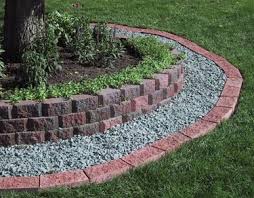One very important aspect about your landscape design is how well it fits with that area it is in, and how well it transitions. There are many materials and techniques landscapers use to make crisp lines for the edges of gardens and beds.
 Brick
Brick- Brick is a common bed edging material. It is practical because it looks nice and is inexpensive. If you decide to use this material, it is important to note that pushing the bricks as close together as possible will decrease the weeds that can come up through the cracks. Also, placing the bricks on top of packed sand will help to prevent heaving and unevenness.
Diagonal Bricks- Placing old bricks on their corners can give an interesting effect to certain beds. These bricks can be hard to come by, but they should be very cheap. Start by digging a trench a few inches deep, and bedding it with sand. This will help drainage, and prevent unevenness. Then place the bricks on a diagonal angle, with only part showing, and press them tightly together. Be careful that your lines are crisp with this design. If either side of the line gets too overgrown it can look neglected and sloppy.
 Cast Concrete
Cast Concrete- Concrete can be a viable option for crisp edging because it is easily manipulated. You can wind paths, adjust the height and even create slopes to match surrounding landscapes. This is great for smooth transitions.
Flagstone- For a country or rustic landscape, flagstone usually fits very well. It is available in many colors so it can easily be coordinated to match your flowers and plants. The uneven and rough edges can be appealing for certain beds. These are practical because they are durable and stack well.
Cobble Stone- Square or rectangle blocks of granite can add a smooth line to your beds. This can look really good with certain plants. It has a rustic and uneven look, while maintaining order in your landscape.
No materials are necessary to make a bed look nice. There are many instances where the best look is a crisp edge, which can be created with an edger. This does require special attention when it comes to trimming the lawn, but is a less expensive solution that may prove to be fitting.
Tyler Kaiser
T. J. Landscaping
.jpeg)

